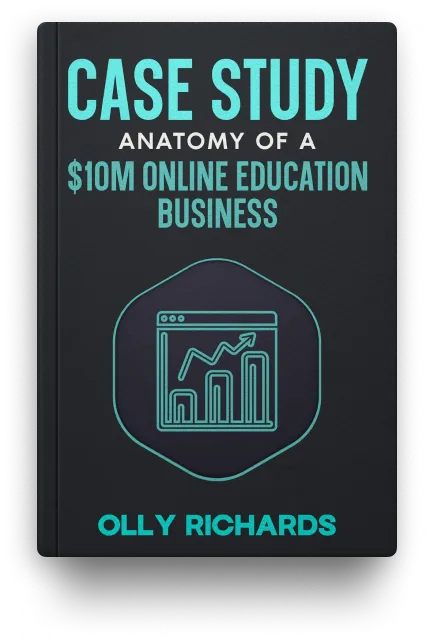While I was in Japan, I received a voice note from a friend.
He was, what I can only describe as, “stewing” about the future of his business.
“Olly, I think I want to sell my business.”
It was “stew” that I’ve encountered many times before, both in my own thinking, but also in other entrepreneurs who find some level of success, and start to step back for the first time to ask the bigger questions.
Here’s the context of my friend’s business:
- My business is doing a few mil in revenue
- Our margins are okay
- We’re profiting around £600k /yr
- But that’s before tax and lifestyle costs
- We’re not getting rich here
- I’m starting to resent the business
- However, selling would only generate a 3-4X profit multiple… that doesn’t feel enough for all my hard work
- I’m interested in new projects that could have higher potential
- I could hire a CEO, but I sense the business would falter if I’m not running it
- I feel really stuck.
It’s the entrepreneurial equivalent of golden handcuffs.
And it’s really f****** common.
You build a 7-figure business, and feel like a superhero.
But, when you’re sitting up in the early hours, nursing a single malt, and reflecting on life (and profit), the truth is…
You’re not getting rich, and it feels like a job.
Yes, you could sell the business.
But that will “only” net you a couple of million after tax, which isn’t enough to retire on… and doesn’t feel like just reward for the years of blood, sweat and tears it took to build the business.
So, what to do?
How long can you hold it together?
So, the reason I remember this was because I started to send a long voice note reply to my friend… from within a quiet local Japanese train travelling from Sendai to Yamagata.
Now, anyone who knows anything about Japanese trains knows that one thing you most definitely do NOT do… is send voice notes.
You just don’t.
The most ubiquitous announcement in all Japanese public transport is:
“Set your phone to silent mode and refrain from talking.”
It’s great, really.
Except I forgot.
I didn’t get told off — that would be too Japanese.
But when I stopped recording and looked around the train, I felt the disapproving stares penetrate me like goddam Cyclops.
Anyway, this topic speaks to a few big areas of entrepreneurial life:
- the ego of owning a good business
- the pride of having built something from scratch with your blood sweat and tears
- building vs managing
- Getting rich and the actual meaning of money
- Working on things you enjoy
…and this is not easy.
You can suppress these feelings when you’re building.
But you have to contend with them sooner or later.
So, in my voice note, rather than give him advice on what to do (you really can’t in this situation), I decided to try and shine a light on the various issues, so that he could see and think through them as clearly as possible.
Here’s a summary of my thoughts to my friend.
1. Having a freedom number
You can’t work on a big financial project like a business without having some idea of where you’re headed.
Especially now that you’re starting to experience resentment.
You’ve got to know what you’re aiming for.
So what exactly is the number at which you’d be prepared to walk away and hang up your boots?
The cash number, or invested assets.
Is it £3m? £5m? £10m?
Park your ego for a minute and just run the numbers — what is your number?
2. Time horizon
Okay, now how long it will take you to reach that number with the status quo?
i.e. cash flowing and saving.
How many years would it take? Put a date on it.
Is this at all realistic or acceptable for you?
e.g. if it would take you another 13 years, can you live with that?
3. Can you get there with a sale?
Can you get to that number faster if you sell the business?
What would be needed to make the business sellable? Is that realistic?
e.g. Let’s say that selling the business would mean hiring two C-level people and two more account managers. What profit would you end up with and what happens to your valuation then?
What does this tell you about the true sellable nature of your business?
4. True goals
Now that you’ve thought about the business a bit more…
Is that freedom number you defined actually a thing? Or is it a false goal?
Do you actually want to be running your business right now?
Or do you secretly want to own the business… just not run it?
5. Future pacing
Now, imagine you have your freedom number in the bank today…
How do you approach your business differently?
Do you run a mile?
Or do you keep going because you actually love it?
What does this say about the truth?
6. Alternative futures
How else might you reach your number?
Is it possible/preferable that a different vehicle might get you there quicker?
All those business ideas you can’t get out of your head… could one of those reasonably have 3-5X more potential than the current business?
Is it worth a punt?
(Remembering that everything becomes a job eventually and the most excited you’ll ever be is before you start the thing.)
7. Half-way house
If you were to install a CEO in your current business and reduce your time to 1-2 days a week…
Would you still be able to make 80% of profit, but enable you to do move on to one of your new ideas?
What does that do to your excitement levels? Or the odds of hitting your number in the next 3-5 years?
…
Seems to me these are the questions you need to ask to understand your own true wants and desires.
From the outside, people always assume that entrepreneurs are super smart.
Usually, we’re not.
We’re just as conflicted as everyone else, and the idea that we know our minds is frankly laughable.
My 2 cents on this…
“I want to sell my business” is almost always code for something else.
Something that’s not right with the status quo.
Trouble in paradise.
(Paradise being inside your own mind.)
If you can examine that, you’ll get to the substance of the problem.
The answer could be to fix something inside your own business.
It could mean hiring or promoting a CEO, to buy yourself some headspace.
It could mean dividing your time and working on something else that fulfils your creative needs.
Whatever it is — if you can fix that, you’ll never want to sell your business, because you’re having too much fun.
Namaste,
Olly
P.S.
Seems that the subject line of these emails gave some people the impression that I wanted to sell my business.
That wasn’t my intention.
Not entirely, anyway…

